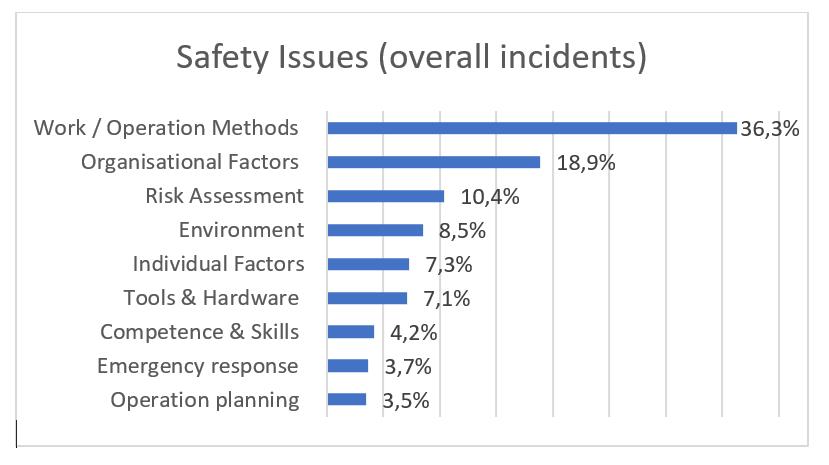EMSA published an analysis of all incidents reported to the European Marine Casualty Information Platform – (EMCIP) during the last decade (17/06/2011-31/12/2021) to detect potential safety issues, revealing that more than 10,000 ships have been involved in navigational incidents related to grounding, collision, and contact.
EMSA categorizes incidents/accidents/ casualties according to their severity (A), safety areas (B) and potential safety Issues (C).
A. Severity Categories
- VS (Very Serious) – a marine casualty involving the total loss of the ship or a death or severe damage to the environment (Res. MSC.255(84), Ch.2.22)
- OMC (Other Marine Casualties) – Serious – Casualties to ships which do not qualify as very serious casualties, resulting in immobilization of main engines, extensive accommodation damage, severe structural damage, such as penetration of the hull under water, rendering the ship unfit to proceed, or pollution (regardless if quantity); a breakdown necessitating towage or shore assistance. (MSC-MEPC.3/Circ.3)
- OMC (Other Marine Casualties) – Less Serious – Casualties to ships which do not qualify as very serious casualties or serious casualties (MSC-MEPC.3/Circ.3)
- MI (Marine Incident) – an event, or sequence of events, other than a marine casualty, which has occurred directly in connection with the operations of a ship (Res. MSC.255(84), Ch.2.10)
Safety Areas
Collision, Contact, Grounding, Damage to ship or equipment, Fire/explosion, Flooding/Foundering, Loss of control/containment, Listing/Capsizing.
Safety Issues
- Competence and skills – It relates to the levels of training, skills and familiarisation acquired by the involved persons.
- Emergency response – It concerns the processes or actions made during an emergency status as well as the availability of the safety equipment or safety mechanisms that are used during an emergency
- Environment – It relates to natural phenomena (external environment) or unexpected conditions of the working environment (internal environment) e.g. Strong wind, tidal effects, reduced visibility, social environment
- Organizational Factors – It stands directly to the managerial domain of the vessel, the company and other organizational system behind various entities e.g. port authorities, VTS services etc.
- Individual factors – The focus is on issues that have to do with the status (physical or psychological) of a person involved, affecting the human decisions, performance or actions.(eg alcohol consumption)
- Operation planning – It relates to the failed planning and decision-making process to manage specific situation, e.g. passage planning
- Risk assessment – The main subject concerns safety or risk assessment, mostly situational, and its conclusions; it may include non-compliance, inadequacy or non-conduction of such an assessment
- Work/operation methods – It relates to the processes and the ways they are carried out on board the vessel.(eg. Bridge manning)
- Tools and hardware (design or operation) – It relates to the design or operation of the vessel or certain of her equipment or tools used on board. (e.g. poor bridge layout or low performance design of alarms)
EMSA Analysis
The report analyzed more than 8,000 incidents related to navigation. An important issue revealed was that an incident may have included more than one Safety Areas, as a series of events. The number of ships involved in these incidents were 10,571 in total (Table 1)
| Type of ships | # | % |
| Cargo ship – solid cargo | 5,160 | 48.8% |
| Cargo ship – tanker | 1,319 | 12.5% |
| Passenger ship – only passenger | 1,143 | 10.8% |
| Passenger ship – passenger and cargo | 1,212 | 11.5% |
| Service ship | 1,710 | 16.2% |
| Cargo ship – Not specified | 27 | 0.3% |
| Total | 10,571 | 100% |
Table 1: Number of ships involved in incidents 2011-2021 / EMCIP Navigation Accident Analysis (Sept.2022)
Taking into consideration the Severity of incidents the following results were identified:
- Very Serious – 123 incidents (1.4%)
- Other marine casualties – 7005 (79.6%)
- Marine Incidents – 1672 (19%)
The consequences to life of humans (crew-passenger-other) were as follows:
- Total Loses – 173 (124 crew, 37 passengers, 12 other)
- Injuries – 719 (124 crew, 37 passengers, 12 other)
The consequences to ships were distributed as below:
- No Damage – 4,044 (45.7%)
- Material damage (Not specified ) – 3,424 (38.7%)
- Minor damage (less than material damage) – 858 (9.7%)
- Material damage (Affecting structural integrity of the ship) – 258 (2.9%)
- Material damage (Affecting performance or operational characteristics of the ship) – 158 (1.8%)
- Material damage (Affecting marine infrastructure or other ship) – 57 (0.65%)
- Total Loss (Actual loss or constructive loss) – 46 (0.6%)
The types of events involved were:
- Contacts – 3,628 (41%)
- Collision – 2,681 (30.3%)
- Grounding – 2,539 (28.7%)


European Marine Casualty Information Platform – EMCIP concluded to results in respect of safety issues (Graph 1), which more or less are the root causes of the incidents, highlighting that human action contributed to the majority of these (Graph 2), in particular to 78% of incidents. Human action as per further analysis is responsible for 84% of Collisions, 75% of Groundings and 71% of Contacts.
Conclusion
The analysis focused on safety investigations data reported in EMCIP, in search of identification of categories of safety issues and more specific areas of concern that have been considered as factors contributing to the occurrences. The primary factor contributing to navigational incidents such as collisions, groundings, and contacts is human action. This is unsurprising given that the Safety of Navigation encompasses various human-related aspects, including actions, the implementation of procedures, the use of technology, and the organization of the bridge.


































































